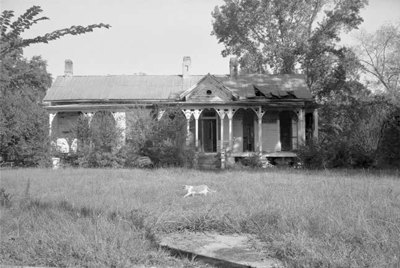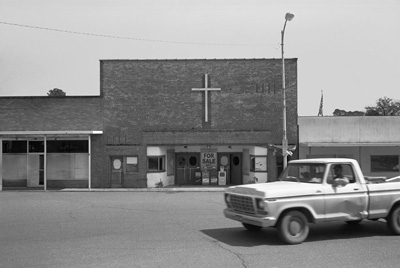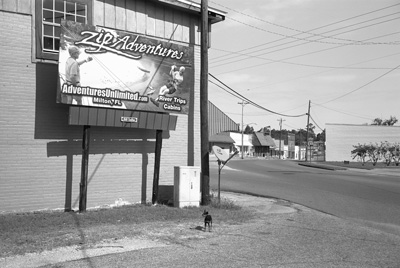
| |
|
"'Sense of place' is a term that is synonymous with the art of the South. It is a term that describes what Southerners hold dear within their psyche and art—a reverence for the land, community, and history. Since 1983, photographer David Wharton has focused his camera on a particular place. A place that at one time defined America yet now is often overlooked and forgotten in our twenty-first century urban society. David Wharton photographs small towns in the American South. The book Small Town South, published by George F. Thompson Publishing in 2012, contains 116 duotone photographs of ninety-four small Southern towns in fourteen states. Small Town South is the culmination of work made by Wharton between 1999 and 2011. These black-and-white photographs are, for the most part, devoid of people. They are instead 'townscapes' that focus on the physical elements of rural communities: contemporary and vernacular architecture, signage, murals, streets and highways, town squares, and historical monuments. These elements serve as signifiers to the cultural values and the social and economic conditions of these communities at the dawn of the twenty-first century. Wharton's photography continues a documentary tradition that is grounded in the visual narrative. His approach to the subject shares characteristics with the work of photographers such as Walker Evans, Eudora Welty, Lee Friedlander, and William Christenberry. Like these photographers, Wharton's comprehensive and in-depth study of a particular place at a particular time serves as a permanent document to future generations of 'how we were' and 'what we looked like' at the beginning of the twenty-first century in the small towns of the American South." —Richard McCabe, Curator of Photography, Ogden Museum of Southern Art "Small Town South by David Wharton is a black-and-white photography essay on small towns typical of the South in the United States. The photos are taken from unique points of view with the purpose of telling a story of yesterday and today. Each reveals something of the past, when some of these towns were thriving. But the photos are of today, showing, in some cases, that the town has fallen on hard times and many people have left, sometimes leaving advertising signs from yesteryear. The photos are a bit depressing and haunting in some cases, and not really beautiful, but are truly journalistic in their unique way of documenting and era gone and an era passing." |
|
| "David Wharton brings a loving and insightful vision to common scenes of small towns in the American South photographed during the first decade of the new millennium. His subjects and his straightforward style immediately inspire a comparison to Walker Evans and other early photographers such as Dorothea Lange, Russell Lee, and Arthur Rothstein who began exploring the same territory and similar subject matter during the 1930s. Wharton's photographs both delight and confound by showing us not only what has changed, but more subtly how much seemingly remains the same yet feels disconcertingly different from the quiet main streets of Depression-era America. Although Wharton's photographs are from ninety-four towns in a dozen Southern states, he does not attempt to create a comprehensive document of any specific town or state. Instead he focuses on the elusive flow of time and how we read time in a place. In so doing, he provides a provocative series of new photographs of the contemporary South and challenges how we might re-read the rich legacy of photographers who preceded him." —Thomas W. Southall, curator and author of Of Time and Place: Walker Evans and William Christenberry |
|
|
|
"David Wharton's Small Town South is a slow, winding visual delight of detail and uniqueness, stitched together by the region's undying devotions to God, country, family, history, and commerce. These exquisite photographs are plainly seen, stripped of drama, yet they are rich in the quiet and complexity of place. Wharton shows us the familiar but only to a point. Though his images are not meant to provide answers to questions about the meaning of the South, they reveal many layers of small town life, giving us timeless glimpses of locales we want to know better." "Small Town South is the single most comprehensive modern photographic survey of small Southern towns. Wharton's purpose, though, is not simply to provide an encyclopedic coverage of a particular kind of town landscape. Rather, he concentrates his vision on what makes these towns significant in the lives of the people who inhabit them, captures the spaces they create over time...Viewing this book, I felt an emotional tug running through it that might be likened to a poetic narrative—evocative rather than explanatory and where much is left to the reader's imagination, which is as it should be in such a beautiful book." |
|
"In an age when many people's experience of the South is from a car window at 70 m.p.h. or through the packaged presentations at New South airports and convention centers, David Wharton beautifully slows our pace and shows us, to quote Faulkner, 'the center, the focus, the hub' of the South through these small town spaces. Taking us to the town squares, storefronts, memorials, main streets, and churchyards of towns throughout the region, Wharton reveals distinctive layers of creativity, culture, and time through his wry eye and careful lyricism. Documentary art at its core, Wharton's captivating new book—refined and nuanced in all ways—reveals the cultural landscapes of the South that we must see and feel to understand fully our time and place."
|
|
|
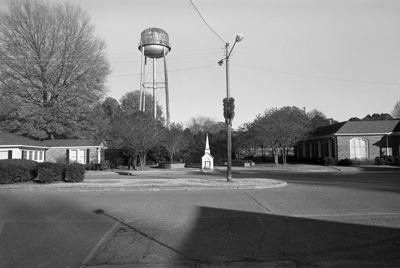 Como, Mississippi
|
"To anyone who's spent any time in, or just traveled through, a small Southern town, David Wharton's photographs will seem both familiar and new. These are places we've known but perhaps never seen as Wharton presents them: often in 'the beautiful noon of no shadow,' in the words of one poet I admire. I love how these images accumulate, page by page, in a sense of irony and humor, persistence and loss. If Wharton's photographs themselves comprise a kind of poem, as he proposes in his introductory essay, it is an unusually moving one—something like an ode, but with an epic sweep." —Rob McDonald, Associate Dean for Academic Affairs and Professor of English and Fine Arts, Virginia Military Institute, and author of four books of photography, including Poplar Forest and Cy's Rollei (with Sally Mann and Evan Rogers)
|
|
| "This limited-edition, horizontal-format book of photographs was beautifully produced by George F. Thompson Publishing and created by David Wharton (Director of Documentary Studies, Center for the Study of Southern Culture, University of Mississippi in Oxford). The author suggests viewing the photographs as a long poem in nine stanzas, where each image relates to the next in ways that evoke but may not build a narrative. The print format, where blank facing pages alternate irregularly with single images printed on each page, also helps to create a sense of slow rhythm. Wharton's subject is the American South of small, empty towns, closely observed and mostly without commentary. The only text is at the back of the book, where each image is given its caption in a couple of sentences or paragraphs, small nonfiction stories about each place. The black-and-white images, of storefronts, signs, roads, and frame houses, have a flat clarity; they could be paintings or photojournalistic moments in which no drama is happening except what is always there. There is an incidental figure, an occasional old truck. His technique is to whisper rather than shout, and the book rewards slow looking. What the photographer draws us in to see has often been exploited for tragedy or kitsch, but Wharton is too wise and too wry; he knows this territory far too well for such easy commentary. Beneath what we thought we knew, he reveals a hieratic landscape. In Cherokee, Alabama, beside a blank brick building and an empty road, an unmarked sign says only, 'DANCE.'" —Eithne O'Leyne, Editor, ProtoView, Ringgold, Inc. |
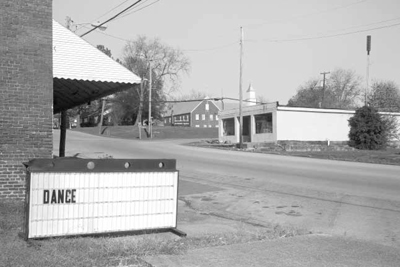 Cherokee, Alabama |
|
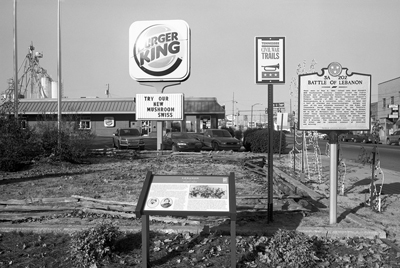 Lebanon, Tennessee |
"The last 150 years have been hard on small rural towns. The incredible advances of the 19th Century had the dual effect of dramatically reducing the number of people required to tend farms as well as drawing those displaced former field hands towards cities with blooming manufacturing bases. The result is a string of small towns that have, undeniably, seen better days. And David Wharton captures slices of this reality. Wharton is quick to assert, however, that it's not quite so hopeless as all that...And make no mistake: there is beauty in the desolation. A welcome home sign for a local National Guard unit being blown violently by an 18-wheeler driving through a town in which it will not stop evokes at once the history and the culture and the life of those towns we all pass by on the freeway. Towns that will never be more than a name on a sign to most of us but which are and have been home to generations of Americans. Wharton shows a keen interest in establishing that sense of place. A Burger King sign inviting customers to 'Try Our New Bacon Swiss' across the street from a plaque commemorating a Civil War battle is, undeniably, a reflection of the South today. Small Town South captures this, and many other moments, with clarity and insight and organizes the pictures with thoughtfulness and intent." —Pelham Anderson, from his review in The Planet Weekly
|
|
"Wharton's images are deeply felt, and they compel deep thought...The photographs include homages to history, as in the antique locomotive in Amory, Miss., and the many memorials to the war dead sprinkled throughout the book, along with newer developments like the courthouse in Hamilton, Al., a pedicure shop in Opelousas, La., or a meat store in Opelika, Al., startlingly juxtaposed with religious signage...The small towns that Wharton photographs often are places that are justifiably proud of their athletic teams, their church groups, their commercial ventures or their military units...Noting that most small towns I have visited remain racially segregated, particularly in areas of housing and some business districts, I asked Wharton if he concentrated on shooting the downtown sections to avoid racial issues. He acknowledges the predominance in the images of Confederate monuments and businesses owned by the white power structure. Yet he says that's what he found in the small towns, and that's what he shot. This let-the-chips-fall-where-they-may attitude pervades the entire book. It's part of what makes Small Town South so unsettling." "I recently revisited Small Town South, the stunning book of photographs you so masterfully crafted and in such times of rediscovery wanted to send congratulations to the artist for this beautiful addition to my library. Absolutely gorgeous—I am in awe." |
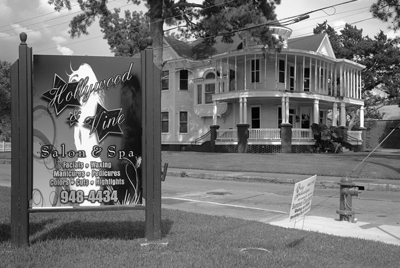 Opelousas, Louisiana |
All content © GFT Publishing. All rights reserved. Cannot be reproduced without permission. Website designed by Morgan Pfaelzer.

